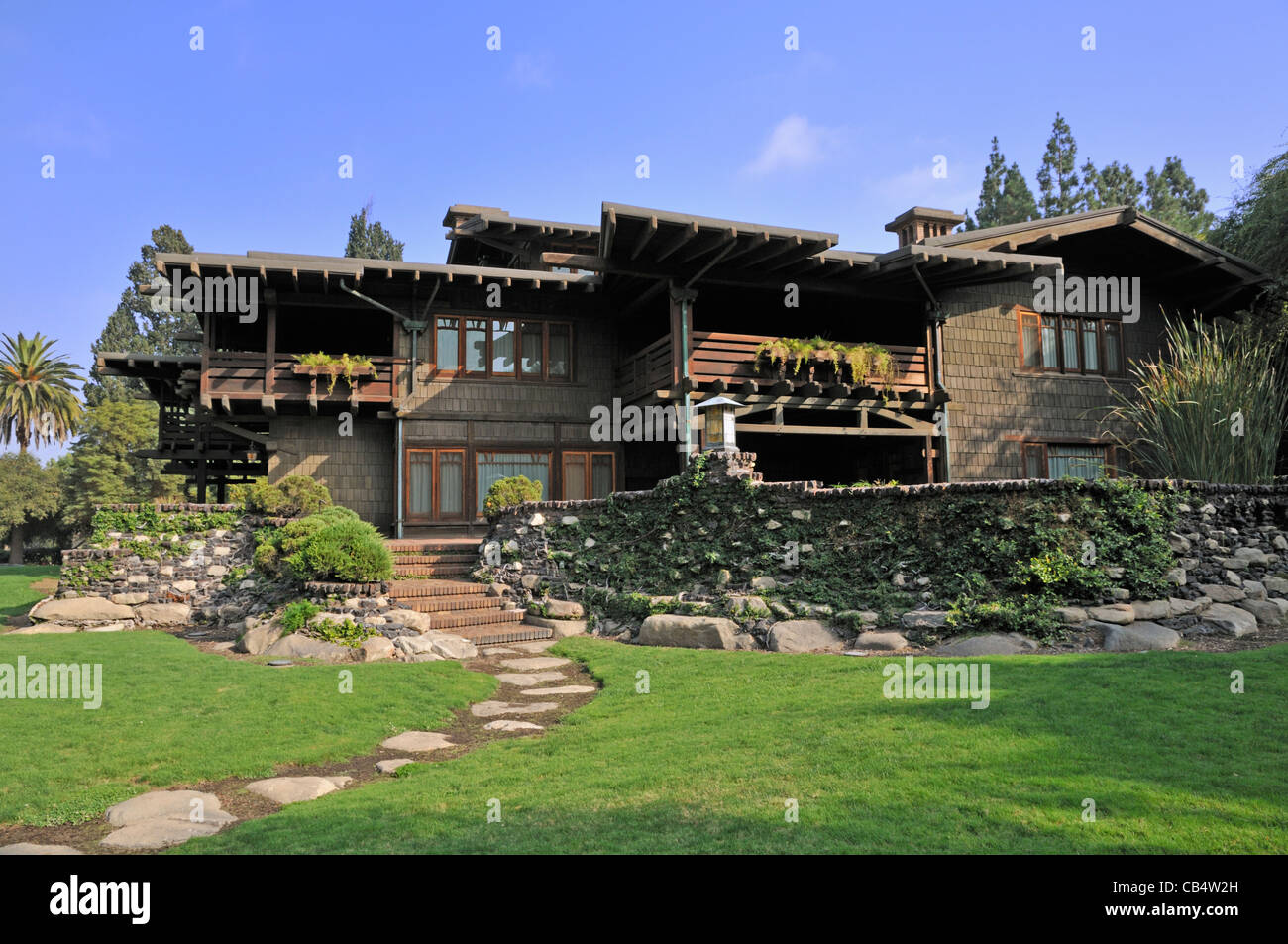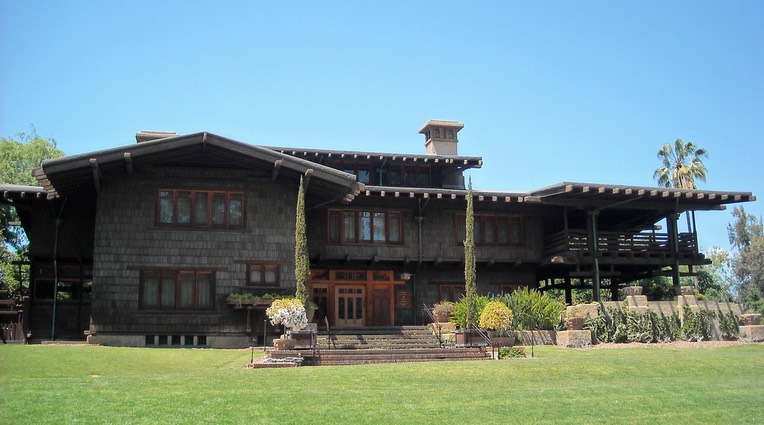Table Of Content

Since 1978, the Gamble House has been owned by the city of Pasadena and run by the University of Southern California. Currently owned by the City of Pasadena and operated by the University of Southern California, the Gamble House is open to the public for tours. Celebrating a diverse mix of art, architecture and history of the Arroyo Seco area, MOTA Day features five unique... One of the wooden panels in the entry hall is actually a concealed door leading to the kitchen, and another panel opens to a coat closet. Please click HERE for photography and film reservations (fees apply) and policies.

The Wood Cake House
At the time, many families from booming cities in the Midwest and on the East Coast were migrating to California in the hopes of a cleaner, warmer, healthier lifestyle. Many of them settled in Southern California and a large group set up camp in Pasadena. The drawings of the house were completed in February of 1908, the site ground-broken in March, and ten months later the house was completed and the first custom-built piece of furniture delivered. The family moved in immediately, and the house and all of it's specially-designed furnishings were officially finished in 1910. The Gamble House in Pasadena, California, is an outstanding example of American Arts and Crafts-style architecture.
Iconic Perspectives: Greene & Greene's Gamble House
Shown here is one of the living spaces that’s filled with intricate woodworking and handcrafted furniture. The various spaces of the house are separated by different wood patterns on the floor. The chevron pattern denotes public formal spaces for entertaining, while the linear horizontal flooring presents private, informal spaces where the family would spend their time. The essential nature of architecture by Greene & Greene begins with intense attention to detail and craftsmanship, as their bungalows mark the height of the American Arts and Crafts style. The brothers were inspired by the concept of total design, or gesamtkunstwerk, which was stressed in the German-designed rooms at the 1904 Louisiana Purchase International Exposition in St. Louis. When they met David and Mary Gamble, they already had developed a list of rich couples who commissioned them to design their houses, with generous budgets and relatively free reign.
Take a video tour through Pasadena’s iconic Gamble House
The Gamble House represented an American-style which sat amidst an abundance of imitations and interpretations of classical European buildings, the influence for many mansions at the time. It was designed to be very suitable for the southern California climate, with a sleeping porch and beautiful transition spaces from the inside to outdoor patios, a garden and a pond. David and Mary lived in the house until their deaths in 1923 and 1929, respectively. Cecil Huggins Gamble and his wife Louise Gibbs Gamble began living in the house after Julia’s death in 1944, and briefly considered selling it. They soon changed their minds, however, when prospective buyers spoke of painting the interior teak and mahogany woodwork white!
Structured Artistry: Gamble House is a fixture in Craftsmen architectural history - Pasadena Weekly
Structured Artistry: Gamble House is a fixture in Craftsmen architectural history.
Posted: Thu, 15 Jun 2023 07:00:00 GMT [source]
Timeline
The strong ties to the outdoors are brought to the interior as well, through flowers and trees which are engraved in the windows, doors and lanterns. Indigenous Japanese shapes appear throughout the house, in the contour of the dining room table, the cloud lift in the transom bar of each window, the recessed handles on drawers and the ebony frame of the master bedroom furniture. We offer a variety of in-depth docent-led tours designed to focus on features of the house that we are not able to cover in a regular one-hour tour.These tours are conducted by docents with years of experience and a great deal of passion. These longer tours allow them to share with you their own excitement and knowledge while giving you a behind the scenes look at what make this historic landmark so special.
David B. and Mary H. Gamble Professorship

At this time, the house passed to the eldest son, Cecil Gamble, and his wife, Louise, who temporarily tried to sell the dwelling in 1945. Efforts to build a high-rise on the Gamble House site came to a head in 1965. To avoid this, a cousin of the Gamble heirs--James Gamble--spearheaded the family effort to preserve the mansion. In 1966, the Gamble Family made an agreement with the City of Pasadena, CA, and the University of Southern California (USC) to maintain the house, and its furnishings, in perpetuity.
The bedrooms are designed to be comfortable and relaxing, with large windows that let in plenty of natural light. The Gamble House was designed by brothers Charles and Henry Greene, who were famous for their Arts and Crafts architecture. The home was built for David and Mary Gamble as a winter residence, and they used it for that purpose until Mary's death in 1929. After David's death in 1923, the home was inherited by his daughters, who continued to use it as a vacation home. In 1966, they donated the Gamble House to the city of Pasadena, with the stipulation that it be used as a museum.
The Greene brothers were known for their Ultimate Bungalows (think supersized Craftsman homes) which were heavily influenced by traditional Japanese architecture, and the Gamble House is without a doubt the finest example of their work. In real life it also bridges time, as the history of the home ties Pasadena’s past to its present. In 1895, David Gamble retired from his position in the family-run Proctor & Gamble Company and began to winter in Pasadena with his wife Mary. Gamble House tours (one-hour tours, specialty and group) are offered on Tuesdays, and Thursdays through Sundays. The mission of The Gamble House is to inspire the public’s appreciation and understanding of architecture as a fine art through the example of The Gamble House, the most complete and best-preserved work of American Arts and Crafts architects Charles and Henry Greene.
Pasadena's Gamble House opens up servants quarters to public (Photos) - LAist
Pasadena's Gamble House opens up servants quarters to public (Photos).
Posted: Sat, 16 Mar 2024 16:18:50 GMT [source]
Do we even dare say that tours of the house provide a chance to travel back in time? After all, The Gamble House famously served as Doc Brown's home, and his lab stood where the bookstore stands today, in 1985's beloved "Back to the Future." "The Gamble House exemplifies the work of Greene & Greene, illuminating the themes in their work that contributed significantly to Southern California's early 20th century artistic heritage and built environment." Inside peek-arounds were put on hold early in the pandemic, while outdoor tours gave devotees of the destination a look at the gardens, patios, and all of that charming brickwork.
The Gambles moved into the completed home in 1909 and lived there until their deaths in the 1920s. The home stayed in the Gamble family until 1966, when it was deeded to the city of Pasadena in a joint agreement with the USC School of Architecture. Today the home is a museum, with two 5th-year USC architecture students living in the house year-round. The third floor was planned as a billiard room but was used as an attic by the Gamble family.
Low-pitched roofs, deep terraces, and titanic, unscreened sleeping porches dominate the exterior of the house. The street view is especially striking for the monumentally deep eaves that shelter the northeast porch, which visually expands the boundaries and overall form of the house well beyond the confines of its shingled walls. In the early years of the twentieth century, sleeping porches were popular and national periodicals promoted them to health seekers and the culturally alert, many of whom came to Pasadena for the winter season. Nowhere did these porches proclaim more boldly the promise of outdoor life than in the Gambles’ winter residence.
The Gamble House's floor plan is integral to its design, and understanding it can help you appreciate the home even more. Although the Greenes never traveled to Japan, they found inspiration closer to home, frequenting the Japanese Garden at The Huntington with its historic Japanese House and ceremonial teahouse. Although, the style did not fully blossom in their work until Charles visited the 1904 St. Louis World’s Fair and its Japanese exhibits, which influenced their designs from there on out. The Gamble House, constructed in 1908 as a home for David B. Gamble, son of the Procter & Gamble founder James Gamble, is widely regarded as the pinnacle of the American Arts and Crafts movement. Today the home is a National Historic Landmark and is open to the public for tours and events.
In order to create such a precise work of art, the Greenes worked with Peter and John Hall, two brothers from Stockholm who were known as master woodworkers, stair builders, and furniture craftsmen. Additionally, they worked closely with Emil Lang, a glass artisan who was responsible for the stained glass that fills the house. The Proctor and Gamble family found the perfect fit when they hired the Greenes. Since their father was a respiratory physician, the brothers also believed in the importance of living a healthy lifestyle full of circulating air and sunshine. They incorporating this theory into each of the houses they designed in their careers. Beginning the tours with such an artisanal masterpiece showed us how much dedicated work goes into keeping these iconic structures alive.
It also consisted of a spacious sitting room, which was decorated with five rugs that were designed by Charles Greene using watercolor. Across from the fireplace, there is a window that leads to the terrace, which overlooks the garden. The expansive window was designed to let light brighten the room during the late afternoon. At the far end of the room lie bookcases, a small games table, and a piano to offer entertainment and leisure. The piano was designed by the Greenes to blend into the paneling of the room.

No comments:
Post a Comment